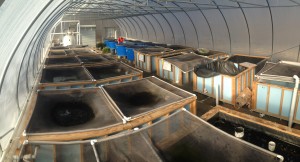Koi Fish Facts
Quarantining Your Koi Fish
As a koi fish owner, an ounce of prevention is worth many pounds (and dollars) of cure. That preventative measure, more often than not, is your quarantine tank.
A “Q tank” is an important part of your line of defense against losing your koi fish unnecessarily. You can always hope that parasites and illness don’t become a reality in your pond or tank, but history and statistics suggest otherwise. Regardless, it is always good to be prepared to minimize any damage that can result from illnesses or environment changes.
We recommend that you quarantine any new fish, from any source, for a minimum of 2 weeks. During this time they should be monitored closely for any signs of illness or infection. If any problems do present themselves, having your new fish isolated in a quarantine tank ensures that the problem will not spread into the population of your primary pond.
Type and Size of Tank
The type of tank material you opt for is important. Some enthusiasts make use of kiddie pools to good effect; but make sure to check if any chemical treatment is used to stop mildew and algae—it can be fatal.
Galvanized tanks have also been shown to be harmful to koi during periods of quarantine. Whether it is Rubbermaid or a polyethylene drop cloth inside of a wooden-framed box, rubber and PVC are better means of housing koi during quarantine.
Much like a pond, the size and depth of your tank will dictate the number of koi that you can safely house in them. Overcrowding is another way of adding stress to a koi that is in a heightened state of anxiety.
Make sure that you have a cover for your tank as well— a stressed koi is a jumpy koi. More than one enthusiast has come to find his quarantined koi outside of its tank. A cover is also a good means to dissuade predation if your quarantine area is outside the house. A plastic mesh cover helps to alleviate the issues that glass can raise at higher outdoor temperatures.

Koi Quarantine Tank Uses
Even though quarantine has its own connotations, a quarantine tank shouldn’t simply be to denote illness. Beyond the obvious function of separating your new pond addition to ensure that it isn’t bringing more than just a splash of color to your pond, quarantine ponds are a great way to provide a calm and controlled environment for new additions to recover from what is a stressful transition period.
Moving from one location to another, especially over large distances, creates the type of stress that can lead to a weakened immune system and an increased opportunity for pathogens and parasite infestation. A clean and well maintained environment will allow the koi to adjust and recalibrate.
It is also a great means to acclimatize any new koi to the ambient pH in the pond that it will call home. Koi are hardy but they are sensitive to pH swings. The water conditions that your koi came from might not match your pond, and simply putting it into your pond—even if you are certain it is illness free—can result in serious damage to your koi. Adjusting the pH gradually will address that issue.
You may have spent years in creating your perfect pond environment. The time you spend making sure that it stays that way (from 6-8 weeks) is a comparatively small time investment.
Temperature
Temperature is an important aspect of quarantine. Water temperatures of 74-78ºF are recommended. Too cold and any treatments won’t be as effective; too warm and any pathogens or parasites get a better environment to proliferate.
Water Quality
This is probably no surprise to any koi fish enthusiast, but the most important part of ensuring a successful quarantine is maintaining good water quality. The usual measures for optimum water quality still apply. It needs to be well aerated with proper means to circulate the water to acceptable levels for the size of the tank. And it will need good biological filtration.
Part of that process is providing a seasoned or “aged” filter in the tank. An aged filter is one that has ready made bacterial buffering on board. It is a filter that houses those aerobic bacteria (Nitrobacter and Nitrosomonas), which will break down ammonia.
Quarantine is not a matter of speed. First and foremost it is to ensure the healthy and stress-free transition of your new koi fish into an unfamiliar environment as well as the safety of your existing koi and their environment. This requires patience and committed, careful monitoring.
Koihealth.info has a quick and ready list of do’s and dont’s for enthusiasts who are looking to successfully quarantine their koi.
At Next Day Koi, you can be assured that your koi fish have already gone through a rigorous quarantine process to ensure that you get healthy fish to add to your pond. All of the fish from our suppliers are quarantined in separate holding facilitates. During the minimum two week quarantine period, fish are monitored for any signs of health issues. Choose from a wide variety of koi fish to stock your pond with.




